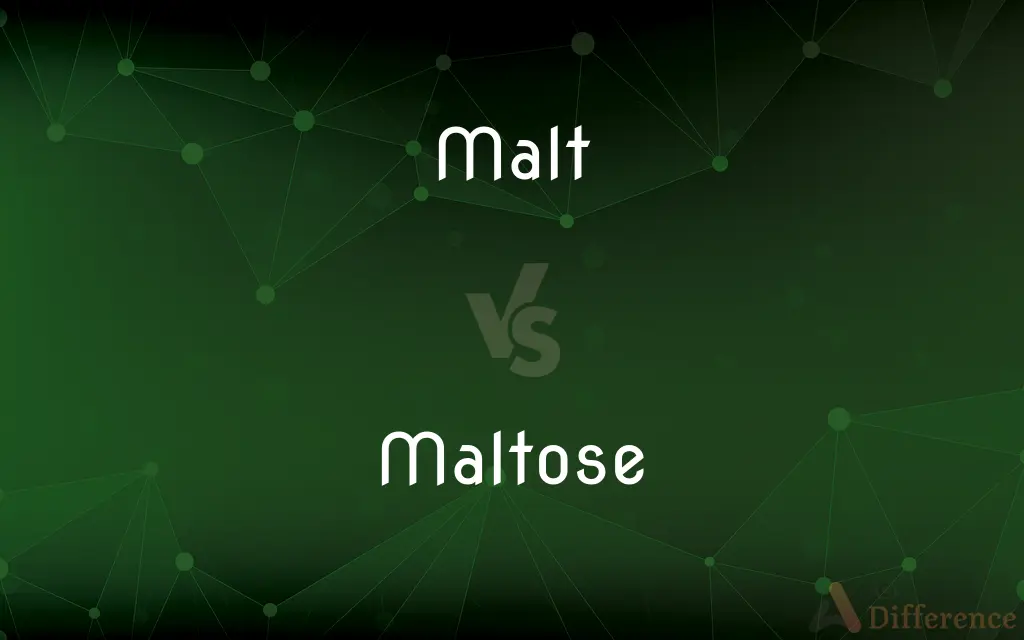Malt vs. Maltose — What's the Difference?
By Urooj Arif & Fiza Rafique — Updated on March 30, 2024
Malt is a germinated cereal grain, whereas maltose is a sugar produced from malt.

Difference Between Malt and Maltose
Table of Contents
ADVERTISEMENT
Key Differences
Malt refers to grains, usually barley, that have been soaked, germinated, and dried, used mainly in brewing and distilling. This process, known as malting, activates enzymes in the grains that convert starches into sugars, including maltose. On the other hand, maltose is a type of sugar, specifically a disaccharide, made up of two glucose molecules. It is created during the breakdown of starches in the malting process and is found in various foods and beverages, contributing to their sweetness.
Malt is an essential ingredient in the production of beer, whiskey, and other alcoholic beverages, as well as in the making of malt vinegar and some baked goods. The malting process gives malt a distinctive flavor that is crucial to the character of these products. Maltose, while produced from malt, is more directly related to the sweetness and fermentability of the product. It is less about imparting flavor and more about providing a fermentable sugar that yeast can convert into alcohol during fermentation.
The production of malt involves soaking grains to initiate germination, then drying them to halt the process at the right time. This careful control is necessary to develop the desired enzymatic activity. Maltose production, however, is a natural result of these enzymes breaking down the starches in the grain into simpler sugars as part of the malting process.
In brewing, the type of malt used can greatly influence the beer's color, flavor, and body. Darker malts can impart roasted or caramel notes, while lighter malts might contribute a bread-like or sweet character. Maltose’s role, conversely, is more uniform across different beers; it is primarily fermented by yeast to produce alcohol and carbon dioxide, with its contribution to the flavor profile being more subtle and indirect.
Malt and maltose, while closely related, serve different roles in food and beverage production. Malt provides the raw materials and complex flavors, whereas maltose offers a key fermentable sugar that influences the sweetness and alcohol content of the final product.
ADVERTISEMENT
Comparison Chart
Definition
Germinated cereal grain, usually barley, used in brewing and distilling.
A sugar produced from malt, consisting of two glucose units.
Primary Use
Ingredient in beer, whiskey, and malt vinegar production.
Provides sweetness and is a fermentable sugar in brewing and food industry.
Production Process
Involves soaking, germinating, and drying grains.
Formed from the enzymatic breakdown of starches in malt.
Flavor Contribution
Imparts distinct flavors to beverages and foods, ranging from sweet to roasted notes.
Primarily influences sweetness and fermentability, with minimal direct flavor impact.
Role in Brewing
Provides enzymes and starches for fermentation, influencing beer's color and flavor.
Serves as a key fermentable sugar, affecting alcohol content and sweetness.
Compare with Definitions
Malt
The process of converting grains into malt for brewing.
Malt production is the first step in the brewing process.
Maltose
A sugar composed of two glucose molecules, resulting from the enzymatic breakdown of starch.
Maltose is less sweet than table sugar but crucial for fermentation.
Malt
An ingredient in non-alcoholic beverages, like malted milk.
They enjoyed a malt beverage at the soda fountain.
Maltose
Found in foods as a natural sweetener.
The recipe called for maltose to add a subtle sweetness.
Malt
A product made from malted grain, such as malt extract.
She added malt to the milkshake for a richer taste.
Maltose
Used in the food industry for its fermentable properties.
Maltose in the dough helps to feed the yeast, aiding in bread rise.
Malt
A flavor descriptor noting characteristics derived from malted grain.
The whiskey had a distinct malt flavor with hints of chocolate.
Maltose
A disaccharide important in various biological processes.
Maltose digestion is essential for converting it into glucose for energy.
Malt
Germinated cereal grains that have undergone drying.
The malted barley gave the beer a rich, complex flavor.
Maltose
A byproduct of malting, important in brewing and baking.
Yeast ferments maltose into alcohol and carbon dioxide in beer production.
Malt
Malt is germinated cereal grain that has been dried in a process known as "malting". The grain is made to germinate by soaking in water and is then halted from germinating further by drying with hot air.Malting grain develops the enzymes (α-amylase, β-amylase) required for modifying the grains' starches into various types of sugar, including monosaccharide glucose, disaccharide maltose, trisaccharide maltotriose, and higher sugars called maltodextrines.
Maltose
Maltose ( or ), also known as maltobiose or malt sugar, is a disaccharide formed from two units of glucose joined with an α(1→4) bond. In the isomer isomaltose, the two glucose molecules are joined with an α(1→6) bond.
Malt
Grain, usually barley, that has been allowed to sprout, used chiefly in brewing and distilling.
Maltose
A sugar produced by the breakdown of starch, e.g. by enzymes found in malt and saliva. It is a disaccharide consisting of two linked glucose units.
Malt
An alcoholic beverage, such as beer or ale, brewed from malt.
Maltose
A white disaccharide, C12H22O11, formed during the digestion of starch. Also called malt sugar.
Malt
See malted milk.
Maltose
(carbohydrate) A disaccharide, C12H22O11 formed from the digestion of starch by amylase; is converted to glucose by maltase; it is an isomer of trehalose
Malt
To process (grain) into malt.
Maltose
A crystalline disaccharide (C12H22O11) formed from starch by the action of diastase of malt, and the amylolytic ferment of saliva and pancreatic juice; called also maltobiose and malt sugar. Chemically it is 4-O-
Malt
To treat or mix with malt or a malt extract.
Maltose
A white crystalline sugar formed during the digestion of starches
Malt
To become malt.
Malt
Malted grain sprouted grain (usually barley), used in brewing and otherwise.
Malt
Malt liquor, especially malt whisky.
Malt
A milkshake with malted milk powder added for flavor.
Malt
Maltose-rich sugar derived from malted grain.
Malt
(transitive) To convert a cereal grain into malt by causing it to sprout (by soaking in water) and then halting germination (by drying with hot air) in order to develop enzymes that can break down starches and proteins in the grain.
Malt
(intransitive) To become malt.
Malt
To drink malt liquor.
Malt
Barley or other grain, steeped in water and dried in a kiln, thus forcing germination until the saccharine principle has been evolved. It is used in brewing and in the distillation of whisky.
Malt
Relating to, containing, or made with, malt.
Malt
To make into malt; as, to malt barley.
Malt
To become malt; also, to make grain into malt.
Malt
A milkshake made with malt powder
Malt
A lager of high alcohol content; by law it is considered too alcoholic to be sold as lager or beer
Malt
A cereal grain that is kiln-dried after having been germinated by soaking in water; used especially in brewing and distilling
Malt
Treat with malt or malt extract;
Malt beer
Malt
Turn into malt, become malt
Malt
Convert grain into malt
Malt
Convert into malt
Common Curiosities
What does maltose taste like?
Maltose is sweet, though less so than table sugar, and contributes a mild sweetness to foods and beverages.
How is malt made?
Malt is made by soaking cereal grains in water to initiate germination, then drying them to halt this process.
Is maltose healthier than regular sugar?
Maltose has similar caloric content to other sugars but is metabolized differently. Its health impact can vary depending on overall diet.
What is malt used for?
Malt is primarily used in brewing, distilling, and the production of malt vinegar and certain baked goods.
How is maltose produced?
Maltose is produced from malt during the malting process, where enzymes break down starches into simpler sugars.
How does maltose affect beer production?
Maltose is fermented by yeast to produce alcohol and carbon dioxide, influencing the beer's alcohol content and sweetness.
What grains can be malted?
While barley is the most common, grains like wheat, rye, and oats can also be malted for various uses.
Can you taste malt in beer?
Yes, malt contributes significantly to the flavor profile of beer, offering notes from sweet to roasted depending on the malt type.
Is malt gluten-free?
No, since malt is usually made from barley, a grain containing gluten, it is not gluten-free.
Can maltose be used in baking?
Yes, maltose can be used in baking to add sweetness and help with yeast fermentation, improving texture and flavor.
Can I make malt at home?
Yes, it's possible to make malt at home by soaking, germinating, and drying grains, although it requires careful control of conditions.
What's the difference between malt extract and maltose?
Malt extract is a concentrated syrup made from malt and contains maltose among other sugars, while maltose is a specific type of sugar.
Why is malt important in whiskey production?
Malt provides enzymes necessary for converting starches into fermentable sugars, crucial for whiskey's flavor and alcohol content.
Does maltose occur naturally in foods?
Yes, maltose occurs naturally in some foods, especially those containing malted grains.
Share Your Discovery

Previous Comparison
Bar vs. Block
Next Comparison
Constructionism vs. ConstructivismAuthor Spotlight
Written by
Urooj ArifUrooj is a skilled content writer at Ask Difference, known for her exceptional ability to simplify complex topics into engaging and informative content. With a passion for research and a flair for clear, concise writing, she consistently delivers articles that resonate with our diverse audience.
Co-written by
Fiza RafiqueFiza Rafique is a skilled content writer at AskDifference.com, where she meticulously refines and enhances written pieces. Drawing from her vast editorial expertise, Fiza ensures clarity, accuracy, and precision in every article. Passionate about language, she continually seeks to elevate the quality of content for readers worldwide.
















































